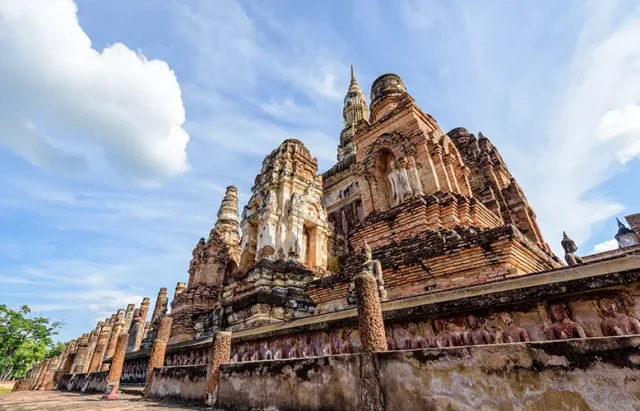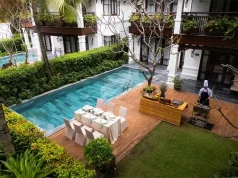
Thailand’s tapestry of history and culture invites explorers to delve into the past. From ancient realms to modern metropolises, this Southeast Asian gem is a treasure trove of historical landmarks that unveil the mystique of its heritage. In this guide, we will journey through Thailand’s historical periods, uncovering the captivating monuments and archaeological wonders that grace its diverse landscape.
The Kingdom of Sukhothai (1238–1438)
Our sojourn through time commences in the heart of the Kingdom of Sukhothai, a period celebrated for its rise as a formidable and independent Thai state.
Sukhothai Historical Park: Designated as a UNESCO World Heritage Site, this park is a sanctuary of ancient temple ruins. Wat Mahathat, nestled within, cradles serene Buddha statues, offering visitors a chance to commune with the past.
Si Satchanalai Historical Park: Another UNESCO-listed site, it safeguards well-preserved temples and artifacts from the Sukhothai era. This historical haven provides a tantalizing glimpse into Thailand’s early civilization.
The Kingdom of Sukhothai, founded in the 13th century, marked a pivotal period in Thailand’s history. King Ramkhamhaeng, considered one of the nation’s great monarchs, established Sukhothai as the capital and laid the foundation for Thai statehood. The Kingdom of Sukhothai is renowned for its independent spirit and cultural contributions, and this is evident in the historical sites that have endured to this day.
Sukhothai Historical Park is the jewel of this period, with its meticulously preserved ruins and temples. The park encapsulates the grace and spirituality of the Sukhothai era. One of its most iconic features is Wat Mahathat, where a serene Buddha statue graces the visitors. This historical site allows you to immerse yourself in the ambiance of an ancient kingdom and ponder the contributions of Sukhothai to Thai culture.
Si Satchanalai Historical Park, another UNESCO World Heritage Site, offers a more intimate look at the Sukhothai period. The park is home to ancient temples, artifacts, and inscriptions that provide insights into the daily life and spiritual practices of this bygone era. As you explore the ruins and contemplate the historical context, you can appreciate the rich cultural heritage that Sukhothai has bequeathed to Thailand.
The Ayutthaya Kingdom (1351–1767)
The Ayutthaya Kingdom, with its grandeur and cultural influence, gifted the world with a trove of architectural and historical gems.
Ayutthaya Historical Park: A sprawling complex that reverberates with the echoes of the Ayutthaya era, showcasing the remnants of temples, Buddha sculptures, and ancient structures. This is a living testament to the once-great kingdom.
Wat Phra Si Sanphet: Celebrated for its three stupas, a symbol of the Ayutthaya Kingdom’s majesty. It beckons travelers to witness the grandeur that once graced this historical era.
The Ayutthaya Kingdom, founded in 1351, was a flourishing and influential period in Thai history. At its zenith, Ayutthaya was one of the world’s largest and most cosmopolitan cities, known for its grandeur and international trade relations. The kingdom’s location at the confluence of three major rivers made it a strategic and thriving capital.
Ayutthaya Historical Park is the primary site that encapsulates the glory of this era. It is a sprawling complex of temples, palace structures, and statues that reflect the opulence of Ayutthaya. The park is a UNESCO World Heritage Site and invites visitors to explore its many wonders, including the remnants of ancient temples, Buddha sculptures, and iconic structures. As you walk among the ruins, you can sense the vitality and cultural diversity of Ayutthaya’s heyday.
Wat Phra Si Sanphet, one of the key attractions within Ayutthaya Historical Park, is renowned for its three stupas. These stupas are a symbol of the Ayutthaya Kingdom’s majesty and its pivotal role in Thai history. Visitors to this sacred site can witness the architectural grandeur and gain a deeper understanding of the kingdom’s historical significance. Ayutthaya, with its rich heritage, has left an indelible mark on Thailand’s cultural landscape, and these historical sites are a testament to its legacy.
The best way to explore this amazing historical city is by joining an Ayutthaya tour from Bangkok covering the main Highlights and most of the temples. Most of the Tour operators in Bangkok are organizing this tour as it’s considered as one of the most recommended and must visit destinations from Bangkok.
The Kingdom of Lanna (13th-18th centuries)
- Lanna unfurls a unique cultural identity and architectural marvels.
- Wat Phra Singh: An exquisite masterpiece of Lanna architecture, nestled in Chiang Mai.
- Chiang Mai Old City Walls and Moats: Time-worn fortifications harking back to Lanna’s resplendent yesteryears.
The Rattanakosin Period (1782–Present)
Bangkok is replete with historical wonders.
- The Grand Palace: Home to the Emerald Buddha, a cherished symbol of cultural import.
- Wat Pho: One of Bangkok’s most ancient and venerated sanctuaries.
World War II and Beyond
- The Death Railway: A testament to sacrifice and suffering, with the Hellfire Pass Memorial Museum.
- Democracy Monument: Commemorates the Siamese Revolution of 1932, transforming Thailand into a constitutional monarchy.
- Erawan Shrine: Deeply embedded in Bangkok’s cultural fabric.
- Jim Thompson House: Blending Thai architectural finesse and art, providing a window into Thai silk production.
In Closing
Thailand’s historical marvels weave a captivating voyage through time, inviting adventurers to traverse its diverse and mesmerizing history. Whether you’re a history enthusiast, an aficionado of architectural wonders, or simply an intrepid traveler, Thailand’s historical treasures promise an enriching experience in the Land of Smiles.





